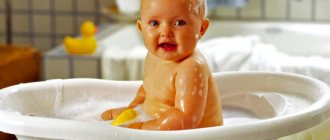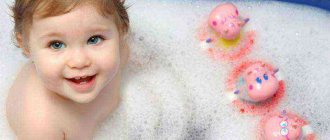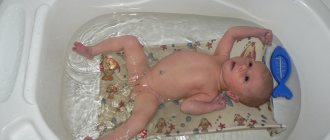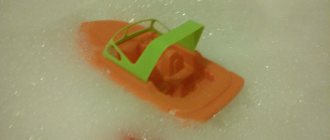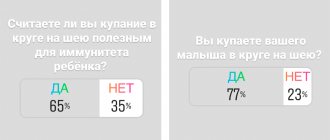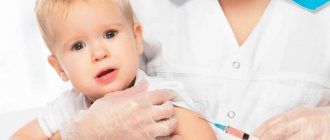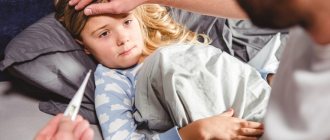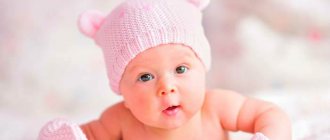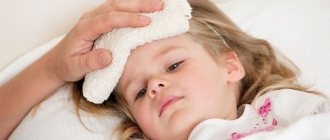Some mothers, wondering whether it is possible to bathe a child with a cough and runny nose, often receive a negative answer. This happens because of established opinions that are passed down from generation to generation. Parents cannot wash their child for fear of harming him, but at the same time they do not think about the reasons for this prohibition.
In order to make a decision in a specific situation, you should know the indications and contraindications for this procedure during a deterioration in health. Having some knowledge about the rules of bathing during illness, you can turn bath procedures into a safe therapeutic event that will only bring benefits to the health of the baby’s body. At the same time, the child will certainly have a lot of fun.
Pediatricians' opinion
Before answering the question of whether it is possible to bathe babies with a cough and runny nose, you should understand what the symptoms are and why they appear. Cough and runny nose are pathological manifestations that most often indicate inflammation of the upper and lower parts of the respiratory system. To assess the likelihood of negative consequences after swimming, you need to take into account several important factors.
Cause of cough and runny nose
It should be understood that rhinitis and cough do not always appear with a cold. Unpleasant symptoms may be the result of an allergic reaction to complementary foods, medications, animal hair, washing powder, etc. In infants, cough syndrome often accompanies the process of teething. During this period, the child’s salivation increases, which causes irritation of the cough receptors in the throat. In addition, cough and runny nose can be a consequence of the development of pathologies in the gastrointestinal tract, cardiovascular and endocrine systems. Therefore, before washing your child, take him to the pediatrician and be sure to determine the reason for the deterioration in his health.
General condition of the child
If a small child, in addition to rhinitis and cough, exhibits other symptoms of a respiratory disease, it is better to refrain from water procedures for several days. Some of the most common signs of developing a cold in children include:
- headache;
- malaise;
- lack of appetite;
- increased sweating;
- chills.
Experts categorically do not recommend washing small patients during periods of exacerbation of infectious diseases. The slightest hypothermia can provoke the proliferation of pathogenic viruses and bacteria, which will subsequently lead to complications - bronchitis, tonsillitis, nasopharyngitis, etc.
Age
Infants are more likely to suffer from overheating and hypothermia, since their thermoregulation system does not work properly. A sharp change in room temperature sometimes leads to local hypothermia of the ENT organs, which negatively affects local immunity. If the cause of your baby’s cough and rhinitis is a cold, it is not recommended to perform water procedures in the first few days after the first signs of the disease appear.
Ignoring precautions in 6 out of 10 cases leads to the development of bronchitis, conjunctivitis and pneumonia.
Children over 2-3 years old can be washed, but only at the stage of resolution of inflammatory reactions in the respiratory tract. To prevent hypothermia, the water temperature should be several degrees higher than in the “pre-painful” period.
Is it possible to bathe a child if he has snot and a Komarov cough?
During illness, the child’s skin sweats a lot, and therefore needs more careful hygiene. If the baby only has mild nasal congestion, then it is recommended to buy it as usual. The main thing is that the water temperature is comfortable for him. Is it possible to bathe a child with a runny nose? Yes, but only if he doesn't have a high fever
If the child does not have a reaction to the herbs, then a decoction of calendula, chamomile or pine needles can be added to the water. They have anti-inflammatory properties and will be useful for the baby.
You cannot use aromatic oils as an additive to bathing water. They can cause swelling of the child’s mucosa, worsening his condition.
Should I bathe my child if he has a runny nose caused by allergies? Yes, but the water must be clean, and any additives, such as foam or herbal infusions, must be excluded. They can increase symptoms that are unpleasant for the baby. The soaps and shampoos used must be hypoallergenic products.
Doctors recommend taking short-term baths, but only if the body temperature does not exceed 37.5 degrees. But they warn that the water should just be warm and under no circumstances hot. Otherwise, the bath will only provoke an even greater rise in body temperature, increasing the heat.
If you have a runny nose or high temperature, it is advisable to replace bathing with regular wiping of the skin with a soft, damp cloth.
After the procedure, the child should be dried immediately.
After taking a bath, the child should be dried and dressed in warm pajamas, given water or fruit drink and put to bed. There should be no drafts in the room. You need to give your baby medicine a little later, about 20 minutes after bathing.
Is it possible to bathe a one-year-old child with a runny nose? The pediatrician who is observing your baby will definitely tell you.
There are several options here:
- If the runny nose is allergic in nature. In this case, it is necessary to bathe the baby, because during water procedures the mucous membrane is moistened and cleansed of the allergen. There is no need to add anything to the water.
- If the runny nose is physiological in nature. Its appearance can be explained by the adaptation of the respiratory organs to new conditions. Copious mucus secretion clears the airways.
- If rhinitis is caused by a cold, it means a weakening of the body’s defenses.
The situation becomes quite controversial when a baby has a reaction in the form of a runny nose to chlorine in the water (it severely irritates the mucous membrane). In this case, the water must be boiled or allowed to stand for 24 hours before bathing.
A reaction to chlorine is not a manifestation of an allergy, but the consequences of irritation of the mucous membrane by this substance. After some time, this type of runny nose should go away.
Advice from Dr. Komarovsky
The appearance of a child in the family is not only joy, but also increased attention of parents to the health of the baby. It is not always possible to protect against diseases no matter how hard you try. And it’s not that they tried poorly to create a safe zone.
The problem is in the immune system, which is only at the initial level of development. The appearance of a cough is accompanied by high fever, runny nose and requires immediate therapeutic action.
But the medicine and methods are prescribed by the doctor. What about maintaining hygiene procedures? Experts differ on whether it is possible to bathe a child with a cough or fever.
Pediatricians' opinion
Before answering the question of whether it is possible to bathe babies with a cough and runny nose, you should understand what the symptoms are and why they appear.
Cough and runny nose are pathological manifestations that most often indicate inflammation of the upper and lower parts of the respiratory system.
To assess the likelihood of negative consequences after swimming, you need to take into account several important factors.
It should be understood that rhinitis and cough do not always appear with a cold. Unpleasant symptoms may be the result of an allergic reaction to complementary foods, medications, animal hair, washing powder, etc. In infants, cough syndrome often accompanies the process of teething.
During this period, the child’s salivation increases, which causes irritation of the cough receptors in the throat. In addition, cough and runny nose can be a consequence of the development of pathologies in the gastrointestinal tract, cardiovascular and endocrine systems. Therefore, before washing your child, take him to the pediatrician and be sure to determine the reason for the deterioration in his health.
If a small child, in addition to rhinitis and cough, exhibits other symptoms of a respiratory disease, it is better to refrain from water procedures for several days. Some of the most common signs of developing a cold in children include:
- headache;
- malaise;
- lack of appetite;
- increased sweating;
- chills.
Experts categorically do not recommend washing small patients during periods of exacerbation of infectious diseases. The slightest hypothermia can provoke the proliferation of pathogenic viruses and bacteria, which will subsequently lead to complications - bronchitis, tonsillitis, nasopharyngitis, etc.
Age
Infants are more likely to suffer from overheating and hypothermia, since their thermoregulation system does not work properly.
A sharp change in room temperature sometimes leads to local hypothermia of the ENT organs, which negatively affects local immunity.
If the cause of your baby’s cough and rhinitis is a cold, it is not recommended to perform water procedures in the first few days after the first signs of the disease appear.
https://www.youtube.com/watch?v=s5WvqulPCio
Children over 2-3 years old can be washed, but only at the stage of resolution of inflammatory reactions in the respiratory tract. To prevent hypothermia, the water temperature should be several degrees higher than in the “pre-painful” period.
Indications and contraindications
For diseases accompanied by a cough, swimming may be completely contraindicated. There is also no need to use the shower, as this can only worsen the child’s condition. You need to focus on the baby himself; if he does not want to carry out water procedures, is capricious and cries, then it is better to postpone them for several days. Hygienic washing is also prohibited in the following cases:
- elevated body temperature more than 37ᵒ C;
- body aches;
- chills;
- general lethargy;
- headache.
Such conditions are observed at the very beginning of the disease, when infections are actively developing and the body is trying to fight them.
In the first days, and in some cases even weeks, babies are given bed rest and a complete refusal to bathe. The body can be wiped with a damp towel or napkin. This is done in a warm room, after the procedure the child is changed into clean, dry underwear and covered with a blanket.
So, children need to be bathed every day; it is good for their physical and psychological health. If the baby coughs, then the procedures should be approached very carefully, weighing all the pros and cons. If you have any diseases, it is better to consult a doctor about maintaining your child’s hygiene.
We suggest you read: What to do if a child’s eye is swollen and red, causes and symptoms of swelling
During a cold, taking a bath or shower is not at all contraindicated, but it is worth noting that in addition to cough or rhinitis, there may be other symptoms in which water procedures may be completely prohibited. The baby should not take a bath if the temperature is too high, or elevated to thirty-eight degrees, which lasts for a long time.
- presence of diabetes mellitus;
- diagnosed diseases of the circulatory system, as well as suspicions of them;
- poor general health of the young patient;
If the child’s health status raises any suspicions among the parents, it is worth consulting with a doctor about water procedures and their implementation.
Most often, when a simple cough with a runny nose occurs without an increase in body temperature, taking a bath or shower is not at all prohibited, and will even promote a speedy recovery.
It is recommended to take short baths if the following symptoms occur:
- poor sputum discharge;
- nasal congestion;
- muscle pain;
- headache;
- poor health, weakness.
But if the baby has purulent inflammatory processes, warming procedures should be completely canceled in order to avoid serious complications and deterioration in the baby’s general health.
When a child has a cold, before starting water procedures in this state, it is worth familiarizing yourself with some rules:
- Your baby should be bathed in water slightly warmer than his own body temperature to prevent overheating.
- When a runny nose occurs, you can take a bath and shower. It should be noted that during a cold, the child’s body weakens, so it may be difficult for him to stand in the shower for a long time, so it is better to reduce his time to ten minutes. You can take a bath until the temperature of the water drops to thirty-three degrees.
- If a cold occurs during the warm season, a shower is not only allowed, it is simply necessary to prevent overheating of the body.
- When bathing during a cold, you should not get your hair wet, especially if it is long, as it takes a lot of time to dry, which can lead to hypothermia in the child and an increase in body temperature.
- It is best to take a bath before bed; this will help calm your baby and set him up for a sound sleep.
Such simple rules will definitely not harm the baby, but still, if symptoms occur in the form of a cough or runny nose, it is necessary to first examine the little patient with a pediatrician and rule out the possibility of serious illnesses. A qualified medical professional will not only tell you whether it is possible to bathe a child with a cough and runny nose without fever, but will also give all the necessary recommendations for his speedy recovery.
Viral or bacterial nature of a runny nose - is it possible to bathe?
When finding out the cause of a runny nose, mothers begin to doubt whether to bathe the child or not.
Specific circumstances and symptoms will help solve this problem.
Source: https://deti-77.ru/uhod/mozhno-li-kupat-novorozhdennogo-pri-nasmorke.html
Washing and bathing are not the same thing
Very often, even after receiving valuable recommendations from a pediatrician regarding the treatment and care of a sick child, parents make mistakes. Few people know that there are fundamental differences between the concepts of “wash” and “bathe”. To clarify, let's look at the definitions of these terms in more detail:
“Wash” – remove dirt with liquid (water) in a short period of time. In other words, washing can be called a banal shower. According to experts, children need to be washed in any condition, even during periods of exacerbation of ARVI. The fact is that during a fever, along with sweat secretions, metabolites of pathogenic viruses and bacteria are removed from the body through the pores on the skin.
If you do not cleanse the skin of impurities in time, this will subsequently lead to the appearance of prickly heat, pimples and boils.
During periods of severe deterioration in the child’s well-being, it is recommended to wipe the body with a towel dipped in warm water. Alternatively, you can use hypoallergenic wet wipes.
“Bathing” is washing the body over a long period of time. Typically, bathing involves soaking your baby in a bath of warm water and splashing your baby for at least 10 to 15 minutes. Swimming is recommended only if the small patient does not have fever or signs of hyperthermia. In addition, after water procedures, it is necessary to create conditions that prevent hypothermia and deterioration of the baby’s well-being.
Bath for conjunctivitis
Inflammation of the conjunctiva, not aggravated by the poor health of the daughter or son in general, does not prohibit taking a warm bath. If conjunctivitis appears against the background of an acute respiratory viral infection, bathe your baby in the same way as we described earlier. After finishing the water treatments, start treating conjunctivitis. Wipe your baby's eyes with a damp cotton pad dipped in boiled water. Apply liquid drops or treat the lower eyelid with ointment that helps with conjunctivitis.
Children tend to catch colds often. Preschool children regularly cough, are filled with snot, and suffer from diathesis (see also: what to do if a child coughs while sleeping?). By being careful with bathing or refusing it during illness, you add dirt to your cold, and with it germs. Use our tips, and water will help you get rid of germs and viruses, and give your child relief and pleasure. Temper your baby, and then the question of bathing with bronchitis or conjunctivitis will lose its relevance.
Precautionary measures
As soon as your child's temperature returns to normal, even if there is still a cough and rhinitis, allow him to take a shower or bathe. To prevent overheating or hypothermia, when performing water procedures, do not forget to follow several important rules:
- the water temperature should be 2-3 degrees higher than usual (the optimal temperature is 36-38 °C);
- before undressing the child, warm the bathroom to 25°C and eliminate drafts in the house;
- the time spent in the bath the first few times after an illness should not exceed 5-7 minutes;
- to speed up the separation of mucus from the mucous membranes of the bronchi and nasal passages, add steamed wild rosemary or eucalyptus leaves to the water;
- Immediately after water procedures, wipe the child’s body dry and dress him in warm, preferably flannel, clothes.
Important! After taking a shower or bath, you should not go outside for at least 2 hours, as this can lead to hypothermia.
During bathing in the bathroom, air humidity reaches 75-80%. According to practical observations, inhaling moist air only speeds up the healing process. Water molecules condense on the inner surface of the nasopharynx, thereby reducing the viscosity of the mucus. Therefore, immediately after hygiene procedures, the baby’s runny nose or cough may worsen. However, this does not indicate a deterioration in health, but rather the evacuation of sputum from the respiratory tract.
Opinion of a pediatric specialist
When the question arises whether it is possible to bathe children when they cough, many parents prefer to find out the answer from an experienced pediatrician . According to the Ukrainian doctor Komarovsky, water procedures are prohibited, but there are some cases when a bath is simply necessary.
Following the doctor’s main advice, monitor your child’s well-being . Even if he has a slight increase in body temperature, it is better to refuse the bath. To maintain cleanliness of the body with this type of inflammation, water procedures must be replaced with wiping the skin with a warm towel.
If the cough is accompanied by a runny nose, but the baby does not complain of feeling unwell, the bath should be replaced with a shower. In this case, the duration of the procedure should not be more than fifteen minutes.
How to properly wash your baby
You can bathe a child if he is coughing, but only if he has a viral or cold infection. However, even in such cases, certain rules should be followed:
- Firstly, the entire bathing procedure should not exceed fifteen minutes.
- Secondly, when swimming, monitor the water temperature. It should not be excessively hot or cold.
- To improve your well-being, add a decoction of medicinal plants to a bath of water. What herbs can be used for treatment are described in this material.
- In addition, during water procedures a small amount of sea salt should be added to the bath. The vapor will improve the function of the respiratory tract, which will speed up the healing process.
- Immediately after water procedures, the child should be dried with a clean towel and then dressed in dry clothes . After the bath, wrap the child in a blanket and place him under the blanket.
- To prevent the bath from harming the baby, after finishing washing, give the child tea with medicinal herbs or warm milk with honey.
- Make sure that your child is not exposed to air conditioning or drafts. You should not walk immediately after the shower.
According to Komarovsky, the lack of water procedures can cause the development of inflammation, so you should know when to stop everything. If you doubt whether a bath is necessary in your particular case, consult your pediatrician.
Bathing rules for various diseases
As already mentioned, cough can be a consequence of the development of several types of respiratory diseases at once. Therefore, before washing a small child, you need to make sure that there are no serious pathologies or disturbances in the functioning of the endocrine and cardiovascular systems. To prevent complications, during hygiene procedures you need to pay attention to the following rules:
| Type of disease | Characteristic symptoms | Bathing rules |
| ARVI | malaise headaches cough rhinitis | You can swim only 4-5 days after infection, the optimal water temperature is 36-37 °C, it is advisable to add essential oils of eucalyptus, pine needles and sea salt to the water |
| gastroesophageal reflux | morning cough, regurgitation of food, sore throat | washing is carried out as usual, it is recommended to add a decoction of medicinal chamomile to the water |
| bronchitis and tracheitis | wheezing when breathing, spasmodic cough, difficulty breathing | You can only shower and only for hygienic purposes |
| nasopharyngitis | barking cough sore throat severe runny nose decreased appetite | Swimming is allowed only during the recovery period; the duration of water procedures should not exceed 5 minutes |
| pneumonia | persistent cough difficulty breathing low-grade fever severe chest pain | at the stage of exacerbation of the disease, water procedures are replaced with wet rubdowns; swimming is possible only during the recovery period |
It is recommended to put your child to bed immediately after showering to prevent hypothermia. It is recommended to lubricate the feet and chest with warming ointment beforehand. However, it should be noted that the use of reflex drugs is allowed only if the child does not have a high fever.
Contraindications
Doctors emphasize the need for hygiene procedures, since children sweat a lot during illness. Along with sweat, metabolites of infectious agents and drugs that need to be removed are removed from the body. Bathing prevents dehydration and promotes tissue oxygenation. However, experts recommend refraining from carrying out hygiene measures in the following cases:
- period of acute respiratory viral infection (first 2-3 days);
- febrile fever (temperature over 38 °C);
- poor physical health (malaise, weakness, nausea).
In addition, it is not advisable to shower more than 3 times a week if you have a severe cough or runny nose. The slightest hypothermia will lead to relapse of inflammation and, as a result, re-development of infection in the respiratory tract.
What is a runny nose
Any doctor will tell you that a runny nose is not a disease, but only a symptom of some disease. Most runny noses in children and adults are a manifestation of ARVI. A runny nose is a protective reaction of the body when a pathogen appears, with the help of which it tries to get rid of the infection.
The mucous membranes of the nasopharynx are lined with special glands that secrete mucus. In a healthy person, they work normally, allowing the sinuses to humidify the inhaled air. In a sick person, mucus is produced by the glands in excess quantities in order to use the active substances it contains to kill the infection without letting it pass further into the respiratory tract.
Attention! Before getting rid of a runny nose, you need to find out what disease it is a symptom of.
Types of rhinitis in infants
Newborns have a formed nasal mucosa, which ensures high-quality processing of the air they inhale to ensure gas exchange in the lungs. Impaired nasal breathing is extremely dangerous for a child during the first 6 months of life. Without the ability to breathe through the nose, the baby will not be able to suck on the breast or nipple on the bottle, which means feeding normally.
Runny nose in a baby
Due to the inability to breathe through the mouth, the child will suffocate, grunt and snore at night. Therefore, it is extremely important to understand the causes of a runny nose, which can be:
- allergic reaction;
- viral infection;
- bacterial infection;
- irritation of the mucous membranes associated with the eruption of teeth in the upper jaw.
Interesting. Dry indoor air can cause the glands of the nasal cavity to work more actively.
Bathing a baby with a runny nose
In order to find out whether it is possible to bathe a child with a runny nose, it is important to determine the cause of the runny nose. Allergic rhinitis is not a contraindication to water procedures.
Running nose without fever
If the body temperature is not elevated, the question of whether it is possible to wash a child with snot should not worry parents. A runny nose in itself without other symptoms of ARVI is most likely a manifestation of an allergy or just a developing infection. Contact with water in such a situation is not dangerous; in the case of allergic rhinitis, it is even useful. Keeping a child in a room with high humidity helps to quickly and successfully wash out dried mucus from the nose and free up the nasal passages. However, you should be careful with diving - if there is swelling of the mucous membrane (stuffy nose), you should not dive, as this can lead to the development of otitis media.
Swimming with ARVI with elevated temperature
If the child's body temperature is elevated, you can take a bath, but only if the general condition is not disturbed. If you are weak and have chills, you should not bathe your child. The answer to the question “is it possible to wash a child with a runny nose and fever” is unequivocal: not only is it possible, but it is also necessary. Hygiene procedures are necessary to prevent additional problems associated with skin irritation under the diaper. Wash the child under running warm water.
Is it possible to swim if you have a cough?
Daily water procedures should be included in every baby's daily schedule. But in some cases, bathing should be postponed. This is especially true in cases where the child has a severe cold or complains of deterioration in health.
If a cough occurs, the first step is to determine its nature. A distinction is made between an infectious, viral or bacterial process. In addition, there is an allergic cough, which is not dangerous to the baby’s health with proper therapy.
How to cure an allergic cough in a child is written in this article.
Water procedures are necessary if the child does not complain of acute symptoms.
Itching and burning in the throat occurs against the background of the appearance of the first teeth , which is often accompanied by copious mucous discharge and frequent dry cough. Such attacks are not a consequence of the inflammatory process, so you should not refuse bath procedures in this case.
In addition, a cough may appear against the background of the development of an illness in the heart or lungs . A cough of this nature is often accompanied by bloody discharge, elevated body temperature and other signs of severe inflammation.
Contraindications to water procedures with a runny nose
Parents whose children have been swimming with an instructor from a young age are wondering whether it is possible to bathe a baby in the pool with a runny nose without a fever. A clear contraindication would be allergic rhinitis. This is due to the fact that almost all swimming pools use chlorine to disinfect water, which will become an additional irritant to the mucous membranes of the respiratory tract. First, you should visit an allergist, who will give his opinion regarding visiting the pool.
Important! If a family regularly visits the bathhouse, it is important to know that overheating is contraindicated for a child under three years of age. In the bodies of children of this age, thermoregulation processes occur differently than in adults. Therefore, high ambient temperatures are dangerous for babies.
Water treatments for colds
Water procedures for a child with a cold are not a contraindication, but only if everything is done accurately and correctly in accordance with doctors’ recommendations:
- You can bathe your child in the shower only after the child has taken an antipyretic and the temperature has dropped to 37 ºС.
- You can’t put your child in the water, you just need to rinse him in the shower.
- The water temperature should not be too high; the optimal indicator is 37 ºС.
- Adding aromatic oils to the bath that have antibacterial or antiseptic properties will help you cope with a cough and get rid of it, or at least soften it.
- After all water procedures are completed, the child needs to be wiped dry with a warmed towel, put into bed and wrapped in a blanket. After 10-15 minutes, you can unwrap the blanket and simply cover the baby with it, after giving him warm boiled water to drink.
- The bathroom doors should be tightly locked when bathing the baby, this is the only way to avoid drafts.
Under no circumstances should you immerse a child in cold water to reduce the temperature; this can provoke the development of white hyperthermia - overheating of the body.
Komarovsky about child health
Popular practicing pediatrician Komarovsky E.O. states that the health of a child mainly depends on the lifestyle to which his parents taught him. To strengthen the immune system, hardening is not required; it is enough not to spoil the child’s health inherent from birth:
- do not be afraid to walk in any weather for at least three hours a day;
- do not isolate the skin of the foot with socks/shoes from the cool surfaces of the floor or summer grass in the yard;
- do not cover your ears with caps indoors, as well as outdoors, if the air temperature is above +18˚C;
- maintain the temperature regime at home, actively ventilating the room, preventing stuffiness from appearing;
- feed children after one year only according to their appetite, without forcing them to finish eating;
- do not lower your body temperature during manifestations of ARVI, if it does not exceed 38˚C;
- form immune protection through timely vaccination.
Walk under the rain
Attention! Nature has built into humans a complex immune system, which, given favorable external factors, can successfully fight most infections. Excessive adult care spoils the child’s ability to cope with pathogens.
What medicinal baths will be beneficial?
As medicine notes, sea water has healing properties against various respiratory diseases, as well as some other diseases. That is why swimming in sea water can relieve swelling of the mucous membranes and help remove mucus from the nasal passages. At home you can imitate sea water, for this:
- dissolve two tablespoons of sea salt purchased at the pharmacy in a full bath;
- leave the water temperature as usual for the child if he does not have a fever, or increase it to 36˚C if the body temperature is elevated;
- After bathing in a bath with sea salt, wash the baby in fresh, warm running water.
You can use a small syringe to rinse your nasal passages with salt water while sitting directly in the bathroom. Salt draws out moisture, that is, it promotes the removal of mucus from the maxillary sinuses.
Runny nose and swimming
A runny nose is a kind of defense of the body. The inflammatory process in the nasopharynx turns into an impenetrable barrier for harmful microbes, preventing them from passing into the body. However, discharge during rhinitis causes discomfort in the child, since congestion is accompanied by difficulty breathing. It is possible to bathe a baby with a runny nose only if he does not have a high temperature. The procedure does not cause any harm, but you should not heat the room too much. Moderately warm air and a bath facilitate the passage of mucus from the nose.
By inhaling healing vapors, the child will receive home inhalation. The body will cope with snot faster, breathing through the nose will improve, and discomfort during sleep will disappear.
Bathing with herbs will not only cleanse the baby’s skin, but also facilitate the passage of mucus from the nasopharynx
Avoid swimming if you have sinusitis or sinusitis: a hot bath is contraindicated for purulent inflammation of the paranasal sinuses. Complications of the disease with nosebleeds or acute otitis media do not cancel bathing, but the child should be washed according to the same rules as at temperatures above 38 degrees. Take note of them and strictly follow them so as not to worsen the baby’s condition.
Prevention of runny nose in infants
In order to avoid a runny nose, you need to avoid contact with viruses. In the modern world, this is impossible to do - visiting any public place can result in ARVI. Mandatory visits to the clinic for preventive examinations increase the chances of becoming infected. In order to reduce the risk of a runny nose, cough and other symptoms of infections, you need to:
- visit public places (shops, transport) as little as possible;
- during forced visits, have drops of saline solution with you for instillation into the nose (while on a bus, for example, you need to generously drip salt water into the nose every 10-15 minutes);
- If possible, visit the clinic with two adults: while dad is in line to see the doctor, mother and baby can take a walk near the clinic in the fresh air without coming into contact with possible viruses.
Attention! In the apartment where the baby lives, it is better to have individual hygiene products and utensils (towels, mugs, pillows). This significantly reduces the risk of infection within the family.
One of the fundamental rules for bathing children and performing any other procedures lies largely in the condition of the child. If the activity does not bring joy to the child, if he cries and in every possible way demonstrates his dislike for immersion in water, even when swimming is allowed for health reasons, it is better to postpone the idea. On the contrary, when a child with a runny nose enjoys bathing in the bathroom, you should not deprive him of positive emotions and stay in a damp room - this will only benefit him.
Video
Source
From a medical point of view, a disease is nothing more than a disturbance that occurs in the normal functioning of the human body. Diseases can be triggered by various pathogenic factors. During illness, a serious disruption occurs in the body, which affects overall well-being, mood and performance.
Modern doctors classify diseases according to many criteria. Most often, diseases are differentiated by the nature of their course, causes of occurrence, method of treatment and prevention.
Experts identify childhood diseases as a separate group. Moreover, some ailments occur so often in children that they have long been considered the norm, and are considered by doctors to be developmental features of children at different ages. However, the child’s body is still very weak and therefore more vulnerable to various diseases. That is why doctors pay such close attention to the treatment and care of sick children.
Where did the ban on swimming if you have a cold come from?
If someone talks about the dangers of washing a child during a cold, then this is nothing more than prejudice. Previously, children were not really washed when they had colds, since there was a high risk of the patient catching an even worse cold. This was explained by the living conditions of our mothers and grandmothers.
Just a few decades ago, not every home had a well-equipped bathtub in which it was possible to properly bathe a child. Most often, water was heated, which was then poured into a trough placed in a large room. It is clear that this room could not be warm, given the old windows and the quality of heating in winter. Therefore, such a hygienic procedure could lead to various complications of the disease.
But bathing in a trough is still half the problem. After all, people often swam in public baths with the whole family, going there in any weather. It was very problematic not to be in a draft there, and going home after washing certainly did not add to one’s health.
Nowadays living conditions are completely different and swimming is a complete pleasure. Modern doctors believe that using water procedures can only speed up recovery. Thanks to warm water and soap, particles of sweat and dust are removed from the skin, the pores open and it becomes easier for the baby to breathe. After taking a bath, the baby becomes calmer and falls asleep well.
Water treatments tone the body well and increase the defenses. After a bath, sick children feel better and nasal breathing normalizes, as the mucous membrane is softened by steam.
Is it possible to bathe a child when he is sick?
Parents often ask doctors whether it is possible to bathe their child during illness. As a rule, the opinions of professionals on this issue differ.
Some believe that swimming can be harmful, while others point to the clear benefits of water procedures. However, the vast majority of pediatricians agree that decisions should be made only taking into account the child's condition.
Therefore, there is simply no clear answer to the question of whether it is possible to bathe a child during illness. Although many doctors believe that water procedures can harm a weakened child’s body. They also agree that from a hygiene point of view, bathing is very important. Of course, a sick child should not take a hot bath, but you can rinse yourself in the shower or dry yourself with a wet towel.
Almost all childhood diseases are accompanied by an increase in body temperature. Experts believe that you can bathe a child at temperatures up to 37.5 °C. Due to high heat transfer, hot water can provoke a redistribution of blood, and this will negatively affect the child’s body, weakened by the disease.
It is also noteworthy that many doctors advise to bring down extremely high temperatures with the help of bathing. To do this, fill the bathtub with warm water (not higher than 36.6 °C) and immerse the child in it. Water can “absorb” excess degrees, thereby helping to ease the well-being of a sick baby.
In addition, at temperature, you can bathe your child in water with the addition of decoctions of medicinal plants. For example, chamomile flowers, sage leaves, calendula or St. John's wort have anti-inflammatory properties. However, if you have some specific diseases (for example, otitis media or skin lesions), it is still better to wait a while with washing.
How to bathe a baby when he coughs?
When answering the question of whether it is possible to bathe a child with a cough, do not forget about the reasons that caused this illness (we recommend reading: how to bathe a child correctly?). In addition, we take into account the general well-being of the baby. Dr. Komarovsky advises not to interrupt the water procedures, but to choose the right washing mode.
- Adenoiditis or viral runny nose - the rules for bathing are identical to those prescribed above for fever and ARVI (see also: acute adenoiditis in children: symptoms and treatment).
- Cough caused by regurgitation during gastroesophageal reflux is not a contraindication to bathing. On the contrary, doctors recommend bathing a child by adding healing infusions to the water. This procedure is also useful for neurotic cough.
- A dry, “barking” cough in an infant signals acute laryngitis, which causes swelling of the vocal cords. A bath can intensify it and worsen the course of the disease. It is more useful for a child to do ultrasonic inhalations, allowing him to breathe cool, moist air. Postpone taking a bath for a few days.
- Bronchitis and acute tracheitis - a warm shower to maintain the child’s hygiene (we recommend reading: acute tracheitis in children: symptoms and treatment). The wet nature of the cough with bronchitis allows you to bathe the baby in a warm bath. Add healing decoctions of wild rosemary, sage, thyme, and plantain to the water. Wheezing, shortness of breath, whistling in the bronchi warn that you should not wash in hot water.
- In case of pneumonia, bathing is postponed until the child’s well-being noticeably improves. The disease is accompanied by high fever, cough, and shortness of breath. Replace washing with wiping with a damp towel. Having passed the crisis threshold, you can rinse your baby in the shower. During the recovery phase, bathing in a sitting position is allowed.
Is it possible to bathe a child with a cold?
It is extremely difficult to protect young children from colds. The slightest draft and the child may catch a runny nose or cough. These first symptoms of illness are familiar to most parents. Children's doctors are often asked whether it is possible to bathe a child with a runny nose and cough, or whether it is not worth doing this until the child's body copes with the disease.
It is worth noting that a runny nose or rhinitis can be considered to some extent a protective mechanism. Inflammation of the nasal mucosa becomes a barrier to viruses that cannot penetrate a weakened body. However, a stuffy nose causes a lot of trouble for both adults and children. You can bathe a child with a runny nose, provided that he does not have a high fever.
In addition, water procedures can serve as an excellent medicine.
During illness, harmful compounds accumulate on the skin and leave the body through sweat. Water washes away toxins, germs, and viral infections from the surface of the skin. Therefore, in case of a cold, runny nose, or cough, it is possible and even necessary to bathe a child, because this helps to increase the effectiveness of treatment.
Although the discussion of whether it is possible to bathe a child during illness is not closed, experts believe that water procedures will not cause harm and will even help if you follow simple recommendations:
- It is worth remembering that at elevated temperatures and in the first days of illness, it is better to avoid swimming so as not to provoke the development of complications. For hygienic purposes, at high temperatures it is better to use rubdowns;
- You can bathe a child with a runny nose, however, there should be no drafts in the bathroom. In order to cure a runny nose, add sea salt to the water and then rinse the child’s nose. True, this procedure should be carried out very carefully and delicately;
- After bathing, the child should be warm, and ideally immediately fall asleep soundly in his bed;
- When a child coughs, you can bathe him in warm water with the addition of decoctions and infusions prepared from medicinal plants that will help in the treatment of colds.
In what cases should you not bathe a child with a cough?
You should not bathe a child with a cough if:
Answering the question whether it is possible to bathe a child when he coughs, the pediatrician warns parents against bathing if the baby’s body temperature reaches 37.5 degrees or higher. The doctor explains that during the bathing period, blood is not distributed in the body in a natural way - it rushes to the skin at the moment when it should flow to other important places. In addition, bathing with a dry and acute cough promotes the production of sputum, and this is dangerous for the child’s life.
You can bathe a child with a cough without fever, while following simple but mandatory safety rules. In particular, the child must feel well, be ready for water procedures, and the bathing itself must be organized and in compliance with the necessary measures. Water is an excellent means of getting rid of many diseases, in particular colds, if used correctly.
